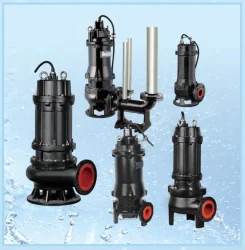Applications of Submersible Sewage Pump
2024-07-08
A submersible sewage pump is designed to handle and transport sewage and wastewater by being fully submerged in the liquid being pumped. These pumps are commonly used in residential, commercial, and industrial settings to manage sewage and effluent. Here's an overview of their features, benefits, and typical applications:
Features
1. Submersible Design:
- Operates while fully submerged in the fluid, which helps in cooling the motor and reducing noise.
2. Construction Materials:
- Typically made from durable materials like cast iron, stainless steel, or thermoplastics to withstand corrosive and abrasive environments.
3. Impeller Types:
- Various impeller designs such as vortex, semi-open, or grinder impellers to handle solids and prevent clogging.
4. Seals:
- Equipped with mechanical seals to prevent leakage and ensure reliability in submerged conditions.
5. Motor:
- Hermetically sealed motor to protect against water ingress, often with thermal protection to prevent overheating.
6. Float Switch:
- Many models include a float switch for automatic operation, turning the pump on and off based on the water level.
Benefits
1. Efficient Solid Handling:
- Capable of handling large solids and debris, making them ideal for sewage and wastewater applications.
2. Quiet Operation:
- Submersible pumps operate underwater, which significantly reduces noise compared to above-ground pumps.
3. Space-Saving:
- Compact design allows installation in confined spaces like septic tanks or sewage pits.
4. Durability:
- Built to withstand harsh environments, ensuring long service life and reliability.
5. Automatic Operation:
- Float switches enable automatic start and stop, reducing the need for manual intervention.
Applications
1. Residential Sewage Systems:
- Used in homes for septic tanks, sewage pits, and basement wastewater management.
2. Commercial and Municipal Wastewater:
- Ideal for municipal sewage systems, commercial buildings, and industrial wastewater treatment plants.
3. Stormwater Management:
- Employed in stormwater management systems to handle large volumes of water and debris.
4. Flood Control:
- Used in flood-prone areas to pump out water and prevent property damage.
5. Agricultural and Irrigation:
- Suitable for pumping wastewater and slurry in agricultural applications.
Key Considerations
1. Capacity and Head:
- Ensure the pump can handle the required flow rate (measured in GPM or L/min) and head (measured in feet or meters) for your application.
2. Solid Size Handling:
- Check the maximum solid size the pump can handle to avoid clogging issues.
3. Power Source:
- Consider the power requirements (voltage and phase) and ensure compatibility with your electrical system.
4. Installation Environment:
- Evaluate the installation site for depth, access, and the nature of the fluid to ensure the pump's suitability.
5. Maintenance:
- Look for pumps with easy access to critical components for maintenance and repair.
6. Warranty and Support:
- Consider the manufacturer's warranty and availability of technical support and spare parts.
By understanding these features, benefits, and considerations, you can effectively select and use a submersible sewage pump for efficient and reliable wastewater management.



